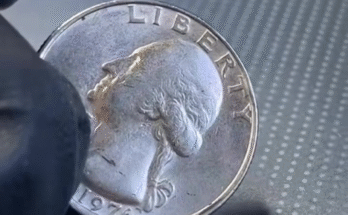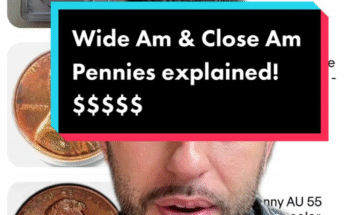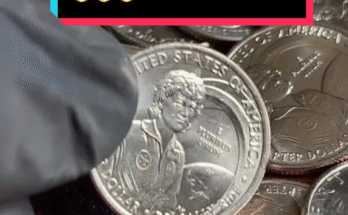A typical 1942-S Lincoln Wheat Cent is common — millions were made — but dramatic mint errors (major doubled dies, mules, or major combinations of errors) could — in extremely rare and hypothetical cases — push a specimen’s value into the six-figure range. Most 1942-S coins sell for far less, but if you find something truly abnormal, here’s exactly how to check it. PCGS+1

1) Why the 1942-S Penny matters (fast facts)
- Mintage: ~85,590,000 struck at San Francisco — so they’re common in general, but errors are possible. PCGS
- Weight & metal: Typical 1942 wheat cents weigh ~3.11 g (95% copper mix). PCGS
- Wartime era: Struck just before the 1943 copper→steel change — transitional years often yield collectible varieties. SD Bullion
2) Could one really be worth $200,000? (be realistic)
Short answer: The $200,000 figure is theoretical — it would require an extremely dramatic, market-moving error (for example a rare mule + top gem grade + unique doubled die combination) and strong collector demand. Most market data and auction records show much more modest prices for normal high-grade 1942-S coins. Treat six-figure values as possible but highly unlikely without proof and grading. SD Bullion+1
3) The 4 error types that can produce big money (what to hunt for)
Look for any of these — alone they’re valuable; combined they’re game-changing:
- Major Doubled Die Obverse — doubling in “IN GOD WE TRUST,” date, or LIBERTY. (Look for crisp, raised doubling, not scratches.) PCGS
- Strong Doubled Die Reverse — doubling on “E PLURIBUS UNUM” or “ONE CENT.” CoinValueChecker
- Wrong Planchet / Mule — a wheat cent struck on the wrong metal or mismatched planchet (e.g., dime or nickel planchet).
- Combination Errors — doubled die + off-center + wrong planchet = very rare and very valuable.
4) Step-by-step: Check a 1942-S penny like a pro (10–60 seconds)
Quick 10-second check:
- Look at the date — confirm “1942” and the “S” mintmark under the date.
- Flip & read — read “E PLURIBUS UNUM” and “ONE CENT” on the back — any doubled or odd letters?
- Weight test — ~3.11 g is normal; big deviation is suspicious. PCGS
Deeper 60-second check (use a table or loupe):
- Use 10x–20x magnifier (loupe). 🔍
- Inspect: IN GOD WE TRUST, LIBERTY, the date, and mintmark for crisp doubled lines. PCGS
- Check edges & surface: look for die chips, clashed devices, off-center strikes, and lamination errors (not damage). CoinValueChecker
5) Red flags — what isn’t a valuable error
- Scratches, corrosion, or natural wear — these are damage, not mint errors.
- Laser-etched or added letters / obvious tooling — often scams.
- Epoxy or surface additions trying to mimic errors (common in fake listings).
6) If you think you’ve found something valuable — exact next steps
- Don’t clean it. Cleaning destroys original surfaces and value.
- Handle carefully (cotton gloves if possible).
- Take sharp macro photos of both sides (use good lighting).
- Weigh the coin on a jewelry scale — record the mass. PCGS
- Get a second opinion from a reputable dealer or coin forum (images first).
- Submit to a grading service (PCGS, NGC or ANACS) for authentication/grading if experts agree it’s promising. Certification greatly increases sellability. SD Bullion
7) Where to sell if it’s real
- Reputable auction houses (Heritage, Stack’s Bowers, and major dealers) — auction visibility often yields best price. PCGS
- Certified-coin marketplaces (with proof of grading) — avoid anonymous sellers or unverified “instant buyers.”
8) Market reality — what prices actually look like
- Typical high-grade 1942-S prices are modest compared with six-figure rumors; PCGS price guides and auction history show high-grade sales in the low thousands for normal specimens, not hundreds of thousands. Use price guides and recent auction results before dreaming of $200k. PCGS+1
✅ Quick Checklist (copy-paste for your pocket)
- Confirm 1942 + S mintmark.
- Use 10x loupe for doubling.
- Weigh — ~3.11 g expected.
- Photograph both sides in natural light.
- Ask a reputable dealer or submit to PCGS/NGC if promising. PCGS+1
⚠️ Final note — be curious, but cautious
Wheat cents are wonderful starter coins: cheap, historic, and occasionally life-changing. But most 1942-S coins are common and sell for modest sums — six-figure paydays are rare and require extraordinary, certified evidence. If you find something bizarre, document everything and get it authenticated. 🔍🪙



Leave a Reply